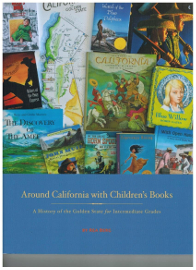Around California with Children’s Books: A History of the Golden State for Intermediate Grades serves as a guide for a one-year course for students in about fourth through sixth grade. This guide is beautifully designed with full-color illustrations. It requires the use of a number of literary works that you can either borrow from the library or purchase. (Beautiful Feet Books offers a complete package with all the literature.)
The course begins by jumping back thousands of years to a period when mastodons and saber-toothed cats roamed the area and to the arrival of those who first crossed the Bering Land Bridge. It then devotes quite a bit of time to Native Americans before moving on to the explorers and settlers of the sixteenth through eighteenth centuries. Students learn about the California missions, the westward expansion, immigrants, the Gold Rush, and modern developments. They read biographies of famous figures in California history such as Father Junipero Serra, John Muir, Biddy Mason, Walt Disney, and Steve Jobs. Nature study also receives a great deal of attention with a focus on animals and the giant redwoods.
Some of the 22 books required for this study are:
- The Discovery of the Americas by Giulio and Betsy Maestro
- California Indians by Elizabeth Sonneborn
- Island of the Blue Dolphins by Scott O’Dell
- The Cruise of the Arctic Star by Scott O’Dell
- Patty Reed’s Doll by Rachel Laurgaard
- Riders of the Pony Express by Ralph Moody
- Jessie Benton Fremont: California Pioneer by Marguerite Higgins
- Blue Willow by Doris Gates
- Song of the Swallows by Leo Politi
- Who Was Walt Disney? by Whitney Stewart
The guide provides some of the actual lesson content along with detailed lesson plans that have assignments, questions, and activities. Parents might read some of the guide content aloud and direct students in their assignments, but I think it will be more efficient if students work directly from the guide on their own as much as possible.
Students will also create a notebook for the course. The notebook is intended to be artistically attractive rather than just a collection of written notes. While students will do some writing in the notebook, they will also use colored pencils or watercolors to color images included with the course for key events, people, and nature studies.
The course uses a four-step methodology—reading, reasoning, relating, and recording—along with other activities such as field trips and cooking.
Typically, students read assigned pages from one of the books (or you read them aloud together), then discuss the questions in the guide. The guide breaks down the reading of each book into groups of pages or chapters, with discussion and activity following immediately rather than after a student completes an entire book. Students are not expected to write out answers to the questions, but they do write out vocabulary words and their definitions in their notebook. The guide has an answer key at the back with suggested answers. There is at least one research project where students are to choose a California tribe to study and then write a brief report (page 21).
The occasional “Nature Connection” introduces students to animals that are native to California. Lovely line-drawn images in the back of the book are to be cut out, colored or painted, and mounted in the student’s notebook. (You might want to transfer images to heavier paper for painting.) They might also write or dictate interesting information about that animal.
“Library Connections” recommend additional books that you might want to read, although I doubt you will have time for additional books as part of your coursework. You might consider letting your child select some to read just for their own interests, aside from the course.
“Culinary Connections” introduce foods that relate to various time periods or cultural groups using background information and recipes. For example, you might try making “Hangtown Fry,” an omelet made with eggs, bacon, and oysters that was very expensive during the Gold Rush. Or try making “Moo Shu Chicken” to connect with the experience of Chinese immigrants in the mid-1800s.
“Field Trip Connections” offer lots of great suggestions accompanied by descriptive information and photos. You will know some important things to look for if you are able to make some of these field trips.
The occasional “Biographical Connection” highlights key people not necessarily covered in the reading.
All of these “Connections” are arranged so that related material is together. For instance, in the section on the gold rush and the transcontinental railroad, there is a biographical connection about Pio Pico, the last Mexican governor of California who was active in both business and politics throughout that period. The next page has a field-trip connection that suggests a visit to Olvera Street and the nearby Pico House, a luxurious hotel built by Pico.
Timeline figures are also included at the back of the guide. Students can color or paint these and mount them in their notebooks. Students will also copy stanzas from “The California Story” poem on page 77 into their notebook—there is one stanza in the poem about each timeline figure. (Students do not create a separate timeline as you might expect.)
While Around California with Children’s Books is not overtly Christian, it gives attention to the founding of the California missions and religious development since this is a major component of California’s history.
This guide is available as either a softcover book or as a download. The pack for the course includes the guide (printed book), the 22 books, and a blank book with acid-free paper for students to create their notebook.
Around California with Children’s Books is a multifaceted course that should be much more interesting than a textbook for learning the history of California.










